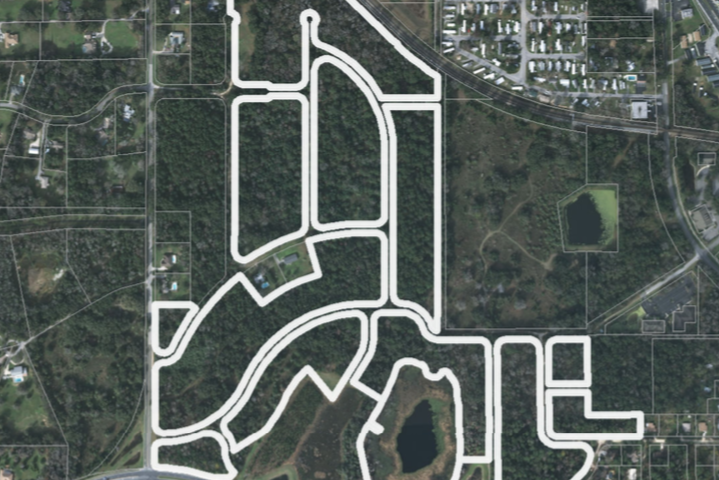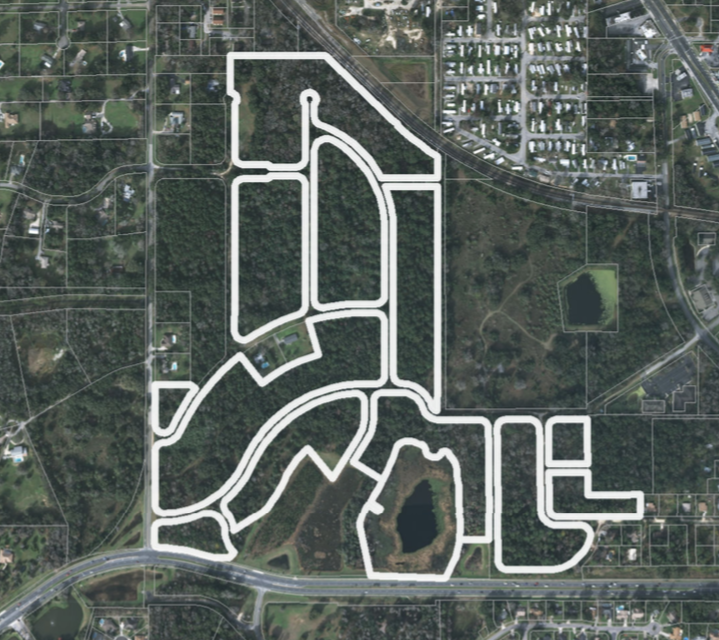City Council greenlights Rudnianyn request to annex potential development of 1,146 units


Aerial shot of the annexed property. [City documents]
The land was previously zoned with the county under a “medium density” land category, which allowed for only four units per acre, whereas the new zoning within the city, despite being described as “low density,” increased that maximum unit number to eighteen units per acre.
Chighizola said that there’s quite a bit of difference between the city’s land use categories and the county’s, which, he said, are much more intensive due to infill development.
“Since 2013, we don’t have low, medium and high density residential classifications,” said Chighizola, but clarified that the city’s zoning classifications have always had more units per acre when comparing them to the county classifications.”
Conflicts of Interest
City Attorney Jimmy Gooding mentioned during the agenda item on Jan. 18 that he does represent the Rudnianyn family, the developer on the project, but had nothing to do with this one.
“On these types of projects, whether in the city or the county, I don’t talk to the client about it,” said Gooding. “But, in any event, obviously, our advice will be for the city only. But I want to let you all know that Mr. Rudnianyn is one of my bigger clients.”
Three-Vote Agenda Item
Gooding told the council, “The first item is annexation of the property or bringing the property into the municipal limits—the property currently is outside of the city limits and within the county limits. It’s a medium residential, which is wonderful land use for the county. The applicant has applied for the low intensity land use classification or asking for that future land use category.
“The next item is often referred to as the policy,” Gooding continued. “Typically, if you just adopt a comprehensive plan, a developer is entitled to do whatever it wants within the parameters of that comp plan category, which establishes a maximum density of 16 units per acre, allows for commercial development as part of the PD, deals with ingress and egress, buffers and access issues.”
Gooding described the process of amending a comp plan as a two-step process: the first thing is transmittal to the state. The state then reviews it, sends back a report.
“The motions on the second and third items that revolve around this property will be a motion to transmit the change in the future land use element and the tax policy to the state for review,” Gooding added. “It won’t be final until it comes back. At that time, you will decide whether to adopt it or not.”
Neighborhood Intensity and Future Development
The vote concerning the annexation of property was 5-0. The vote concerning the transmittal to the state was passed 4-1, with Councilman Jim Hilty dissenting. The third and final vote concerning transmittal of the tax policy was passed 4-1, with Hilty again dissenting.
Hilty wished to reduce the intensity level to the lowest possible land use category within city limits, “neighborhood-intensity.” He also brought up recent developments planned to go up close to the 88 acres in question and their potential added impact to the city.
“We’ve got an apartment complex going up just to the west of 200. One thing that I was against was the development of the Red Oak property, which is just, again, a little bit more to the west. That’s going to be hugely developed. That’s project was stalled, not sure where that is exactly. But you’ve got that potential out there, and one of the problems I always see is that something like this gets approved. It sits there for a couple years. And in the meantime, why did things get approved? So, we really need to get a whole handle on what else is around it.”
Hilty asked if they could annex the property into city limits yet keep the zoning the same as the development already had in the county.
“If you annex it into the city, you have to give it a land use. We can’t adopt the county’s land use,” said Tye Chighizola.
“We have nothing comparable is what you’re telling us?” Asked Hilty.
“Neighborhood would be the next lowest one, which is basically five units per acre for low and for single family, 12 units per acre for multifamily,” answered Chighizola.
Mansfield said he didn’t want to kill the whole project.
“I agree with the growth. We need the homes. I’m really concerned about, not only this project but with other projects too, is the density. I would like to see more of a definite exact plan of what we’re trying to accomplish,” he said.
1,146 Units
The proposal as outlined by Tye Chighizola would be a combination of single family and multifamily, with the multifamily being near the intersection of 7th Avenue, 42nd and 31st—what Chighizola called “the 31st corridor” but also commonly referred to as Lake Louise.
Gooding told the council that that there had been discussion about this property possibly coming in the city limits for a number years. It was an old platted subdivision, where there are some houses currently situated. The rest is open and other planned houses never got off the ground.
“There’s been a number of years we’ve been talking about annexing this property,” said Gooding. “It is contiguous to the city. And there is low intensity land use, surrounding it to the northeast, mostly along the corridor and 441. So, it’s land use is consistent, and that’s what the applicant is proposing: low intensity land use.”
Chighizola explained to the council, “When we annex it in, we would have to give them a land use category. Neighborhood is our lowest intensity within the city. Low intensity is the next step up, and then we have medium intensity and high intensity.”
The applicant requested the low intensity, said Chighizola, adding that the city is requesting a policy change to a PD development, limiting the number of units to 16 units per acre or a maximum of 1,146 units.
“If you do the calculation, it won’t turn out to be 16 units per acre across the entire 89 acres,” said Chighizola.
Traffic Study
There will be a future traffic study conducted before the PD can be approved, said Tye Chighizola. He called this the next step after the designated land was annexed and transmittal of the policy approved.
Fred Roberts, attorney for the applicant, addressed some concerns he knew the public had mentioned in regards to the project.
“The traffic component, I think, is one that’s been raised significantly and appropriately,” he said. “We fully anticipate that a traffic study will be done. And I think it’s going to be up to somebody…some modification based upon the revised plan for major traffic improvements to occur at the intersection of Southwest 7th Avenue and Southwest 32nd Street, including a new signal to be installed at the developer’s expense and an additional turn lane.”
Confusing Categories
Chip Young, who mentioned he lived at 600 S.E. 48th Ave in Ocala during the meeting, described himself as an owner of a home currently located in the middle of the existing platted subdivision complained that none of the surrounding property owners had been notified during this process.
Young also thanked Gooding for admitting that he represents the Rudnianyn family.
“In matters of this magnitude in the city, I am aware that the city…or excuse me that your firm did write a letter to the city staff regarding this specific project as it applies to annexation. So, I want to put you guys on notice that I believe there could be a potential conflict,” said Young.
“We own property in the middle of this subdivision,” said Young. “The applicant wants to annex around us and not include us. We would be interested in annexing but not under the density that’s being proposed. What I would recommend is that the density be allowed and development occur for the existing plat and density that has been in place for well over 50 years.”
“And I request that the council here who has the final decision with this really understands the implications and impacts of the substantial high density development that’s being proposed. It’s not necessary. The current landowner can develop that property under the existing land plat and make money, all while delivering homes, residential units, out there for the good of the growth of Ocala.”
Young also mentioned how the differences between city and county land use categories were confusing.
“What’s the county right now? It’s medium density. But yet the applicant is stressing low intensity. There’s nothing low intensity going from medium density of so many units per acre up to a potential 18. That’s misleading. A lot of property owners out there do not understand the implications of this,” he said. “I would recommend that everybody take a look at the entire picture of what the impact is going to be out there. And the impact and effect it’s going to have on the city with traffic.”
“I think the process as it’s laid out here is the correct process to follow,” said Gooding. “I think we should annex it in. And I think we should issue the transmittals, because it’s a tremendous amount of leeway in controlling the final development of it. We’re talking about traffic issues. And we can’t get the traffic study unless we annex it.”
Concerns
Jim Hilty brought up locals schools, asking Chighizola whether or not they could handle the increase in additional students brought on by the proposed development.
Chighizola conceded that some schools might indeed suffer from overcrowding, but the entire district, not just individual schools, determined capacity as a whole.
“So, they would be able to move people from one school to another, to help balance it out,” said Chighizola, adding that city policy allows the council flexibility in such matters.
“If you decided you did not want to do low intensity, you could drop it down to neighborhood,” he said. “And if you wanted to amend the policy further to say you only want 500 units, for example, or 600 units—that’s what the policy allows you to do. Otherwise, you’re stuck with the land use category, maximum and minimum densities.”





